As an Amazon Associate, I earn from qualifying purchases with no additional costs for you.
The folk costume can be described as the traditional clothing of members of nations, ethnic groups, or regional or local communities. In Slovakia, dressing in folk costume has a long tradition and belongs to the national cultural heritage.
The traditional clothing in Slovakia is a folk costume called a kroj. Its history dates back to the 16th and 17th centuries when the first decorated costumes began to emerge. The most distinctive elements of the kroj are embroidery, its techniques, ornamentation, color, and composition.
Read more about beautiful traditional Slovak folk costumes and find out about different types of Slovak folk costumes for each region in Slovakia.
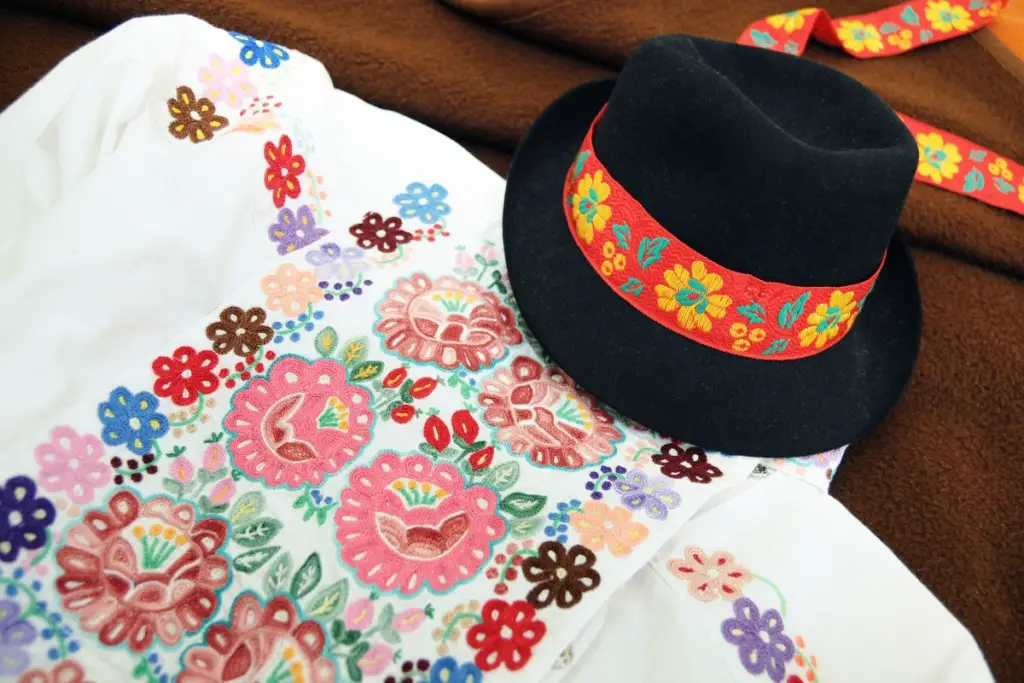
If you want to buy Slovak gifts or useful Slovak products, you can find them by clicking here (Amazon link).
What parts of clothes make a folk costume?
Women were led to sewing clothes from an early age, they began to learn to sew as girls aged 5-6 years. Embroidery was part of the curriculum in folk schools throughout Slovakia.
Folk costumes for girls and women
Women were led to sewing clothes from an early age, they began to learn to sew as girls aged 5-6 years. Embroidery was part of the curriculum in folk schools throughout Slovakia.
The basis of a women’s folk costume is a canvas petticoat (shroud), braid (sleeves), shirt, apron (hoop), skirt, cap, wool aprons, cloth three-quarter jackets, and fur coats.
Women’s folk clothing was basically divided into lower and upper parts. The lowest part was the shroud, consisting of two parts: the upper top piece extending from the waist to the armpits and the skirt sewn to it.
The oldest skirt that women remember was a white rope skirt (fortuch). The material varied according to the occasion for which the skirt was intended.
Nowadays, women wear such skirts as festive skirts. Girls also wore festive skirts made of flowered brocade of dark colors. An apron was tied around the skirt.
The upper parts are characterized by rectangular fabrics, which have survived in several types. These included a cape that covered the head and shoulders.
Folk costumes for boys and men
Men’s clothing in the mountain regions of Slovakia is divided into linen and woven cloth. Men’s linen clothing consists of linen trousers, a shirt with wide sleeves, and an apron.
Woven clothing consists of woven cloth trousers and a wide-sleeved shirt. The garment varies in decorative elements, embroidery, ornaments, and colors.
Both single and married men always wear a hat on their heads and a fur cap in the hard winter. In western and south-western Slovakia, slippers were characteristic of footwear. Leather boots were used as festive footwear.
Belts are a separate chapter of Slovak costumes. Over time, they have become a distinctive decorative element of men’s folk clothing. Other leather accessories, such as shepherd’s bags and shepherd’s whips, have followed the same development.
Each part of Slovakia has a different folk costume
Slovakia is one of those countries where folk clothing was characterized by an exceptionally rich variation and was preserved in several areas until the middle of the 20th century.
In every part of Slovakia, the folk costume looks different. Of course, all costumes have some common features, thanks to which they differ from the folk costumes of other countries. We find the difference, especially in the choice of colors, ornaments, and embroidery used.
Folk clothing was also differentiated according to the activities in which it was used. In the past, a distinction was made between folk clothing for the following:
- traditional clothes for daily use
- celebration folk costumes
- wedding traditional clothing
Traditional clothes for daily use
Traditional casual clothing was essentially the same throughout Slovakia in the past. It did not contain any decorative parts but was above all practical and suitable for everyday work.
These casual clothes were made of flax, hemp, or yarn. They were not bought, but women and young girls sewed them by hand at home. Canvas shirts and cloth trousers are part of men’s casual and workwear. On the other hand, women most often wore a shirt with a skirt and an apron.
Celebration and wedding folk costumes
Celebration and wedding folk costumes are the “real” kroje. This clothing is characterized by distinctive colored and decorated elements.
The decoration of the folk costumes is different throughout Slovakia, typical for each region. Therefore, I will pay attention to each region separately, so that you can see how beautiful and diverse Slovak folk costumes are.
TIP: Do you know what to wear to a wedding in Slovakia? Check out the complete guide in the article below:
Local Tips on What You Should Wear to a Wedding in Slovakia
Folk costumes from Western Slovakia
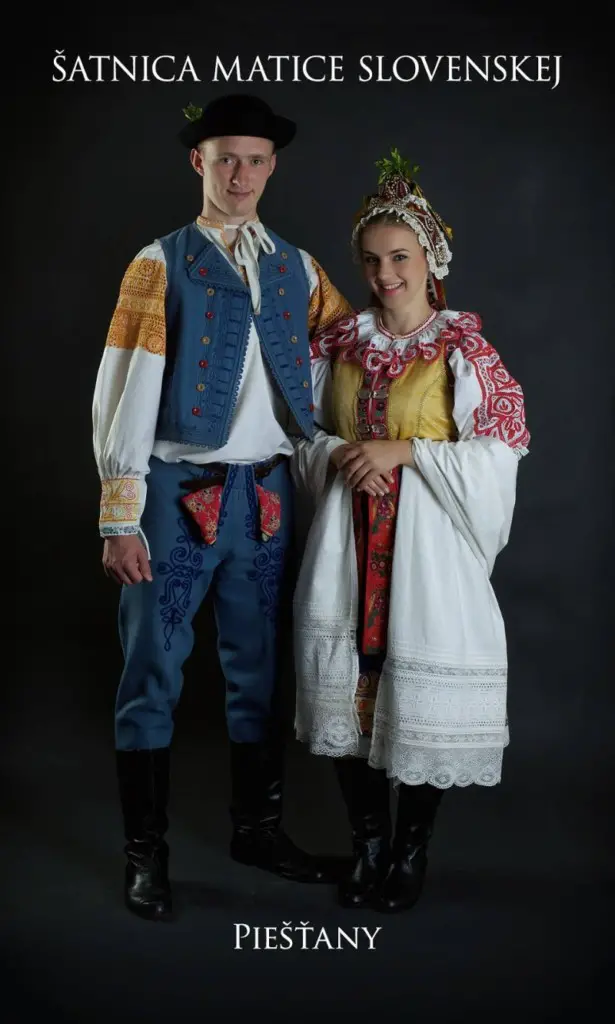
Richer regions, such as western Slovakia, could afford more embroidered and therefore more ornate folk clothing.
Western Slovakia is represented mainly by the women’s costumes from the Myjava Hills and the men’s costumes from Cífer.
Folk costumes from Trnava

The area of Trnava clothing is one of the largest in western Slovakia. It includes around 200 villages in the Trnava and Bratislava districts; it extends beyond the borders of Bratislava county into the neighboring Nitra county. It is roughly the area bounded by the municipalities of Modra, Častá, Dolné Orešany, Smolenice, Trstín, Dechtice Cífer.
The Trnava costume was one of the most decorative Slovak costumes. Especially embroidery stood out – various demanding techniques, such as punched embroidery, gold and silver embroidery, and full embroidery – with silk, wool, and cotton.
Folk costumes from Central Slovakia
Central Slovakia has perhaps the most varied range of regions that have preserved impressive folklore and cultural heritage to this day.
From Goral villages where people lived, sang, and danced bravely in the hard conditions of the Orava hills to Detva’s folklore with the unique sound of the fujara (folk shepherd’s overtone fipple flute).
Folk Costumes from Detva
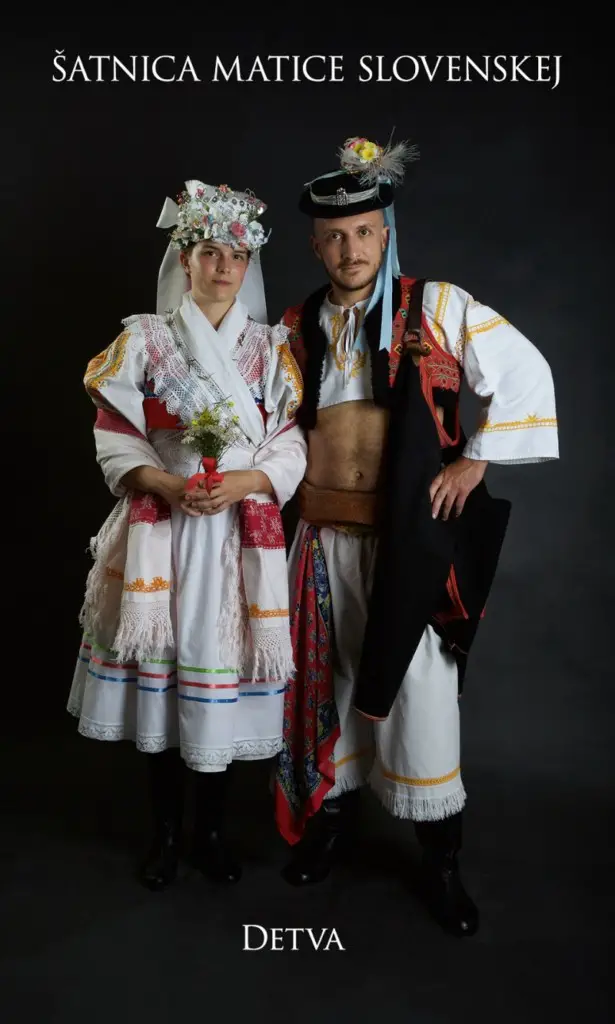
The hill region of Detva is one of the most famous and most spectacular locations. The pride of Detva is the original and richly decorated costume, which is still owned by many local inhabitants.
The unmistakable men’s costume with a short shirt halfway down the chest is unlike any other costume in the region.
TIP: Children, young people, and adults have spent a lot of time in nature in the past and therefore various games were created in this environment. Check out traditional Slovak games in the article below:
10 Traditional Slovak Games for Children, Youth, and Adults
Folk costumes from Northern Slovakia
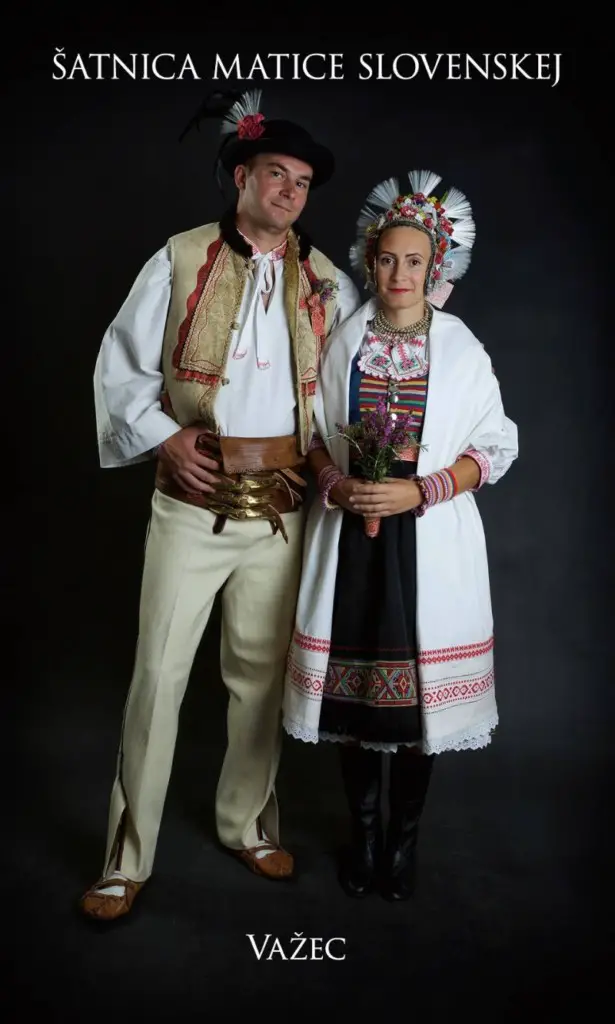
Regions in Northern Slovakia are known as the richest folk region in Slovakia. Check out the most interesting ones in the sections below.
Folk Costumes from Kysuce
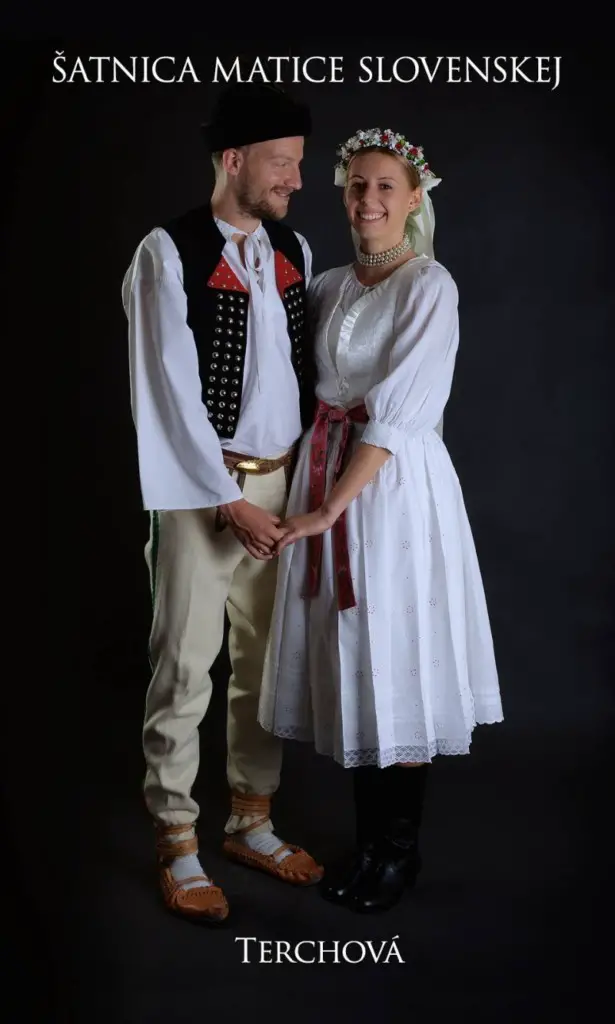
The region of northwestern Slovakia – Kysuce – is bordered by Polish ethnicity in the north and Moravia and Silesia in the west. Folk dress reflected the poor economic conditions.
The whole area can be divided into two sub-areas:
a) the area around Žilina to Čadca (lower Kysuce)
b) the valley of the Kysuce River from Makovo to Čadca (upper Kysuce)
The clothing of the Upper Kysuce region has no distinctive decoration. There was little embroidery, it is fine, designed in strips, densely embroidered with untwisted silk in red, yellow – the older ones in white. The overall color scheme of the garment is white-black-red.
Folk Costumes from Liptov
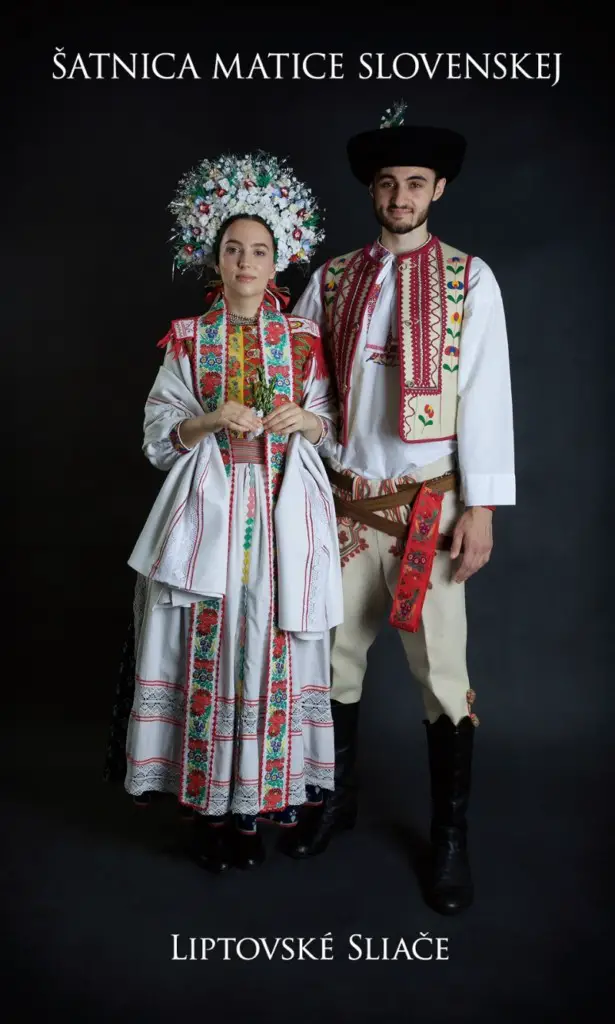
Liptov, a region located in northern Slovakia, can also be proud of its specific costumes. Apart from the fact that Liptov is characterized by its beautiful alpine nature, Liptov customs and traditions were influenced by the shepherds, German miners, and different crafts. The women’s costume is colorful and has an original decoration.
The basic part of the Liptov costume is the petticoat, which was linen and was four-piece. Women wore a linen belt over it, which was characterized by beautiful embroidery – initially cotton or wool, later also decorated with crocheted lace.
An essential part of women’s costumes is the skirt, which changed color from white to dark grey after the First World War. On the skirt, women wore aprons, which had a dark blue base and a distinctive white pattern.
As already mentioned, the Liptov region was inhabited by the shepherds, which led to the wearing of sheep’s wool sweaters at the beginning of the 20th century.
Women wore floral crowns on their heads or wreaths made of various ornaments, or embroidered caps. On their feet, both women and men wore peasant shoes and later boots.
TIP: Wondering what traditional breakfast Slovaks eat? The traditional Slovak breakfast was one of the most hearty meals of the day. Find out more in the article below:
What are Traditional Slovak Breakfast? 5 Typical Breakfasts
Folk costumes from Eastern Slovakia
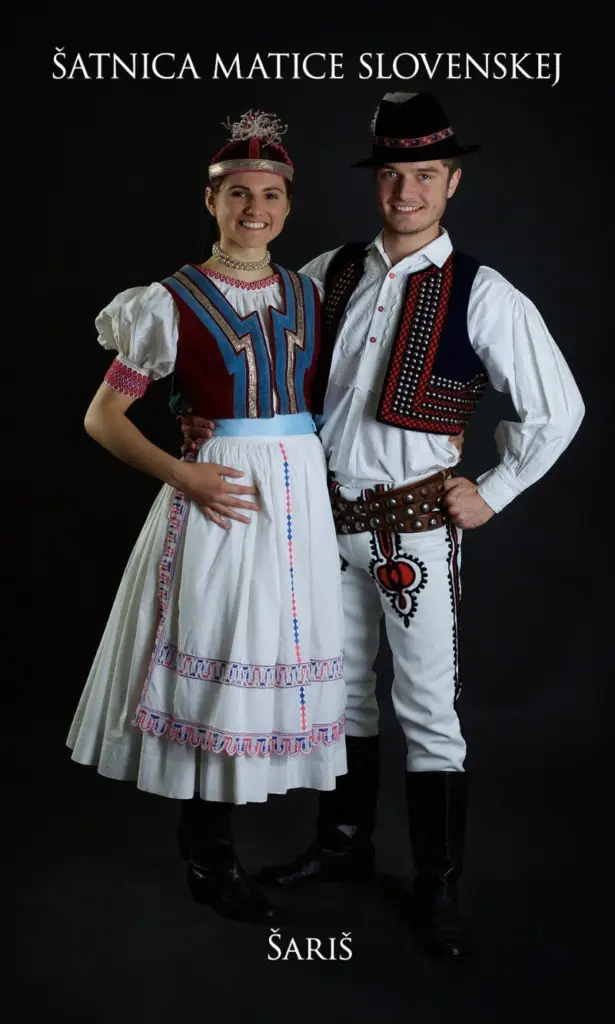
Eastern Slovakia offers diversity and countless beauties – from the majestic peaks of the Tatra Mountains to the vast plains of the Eastern Slovak Lowland, which stretches to the borders with Hungary and Ukraine.
This unique location and the proximity of other cultures have also influenced the variety of costumes and the colorful, dynamic folklore typical of eastern Slovakia.
Folk Costumes from Zemplín
The Eastern Slovak region of Zemplín is represented by its lively folklore. The diverse ethnic composition of the region has contributed to the varied cultural heritage of Zemplín. In the neighborhood, besides Slovaks, there are also Hungarians, Ruthenians, and others.
The costume of this region is characterized by its varied colors and its variability in terms of cut. Unconventional materials were used in its creation, which was influenced by the migration of local inhabitants to America.
The first costumes were embroidered only in black and white, and later came the era of full-color decoration. The rich skirts and brightly colored geometric patterns stand out beautifully in the karička – girls’ dances for which Zemplín is famous.
There is no region in Slovakia where women’s round dances are as strongly represented as here. Karička is danced throughout the region, at every dance occasion and celebration.
TIP: Check out my list of recommended Slovak products. They are perfect as gifts, or you will use them during your visit to Slovakia (Amazon links)
- Slovakia Flag
- The book about Slovak History
- Slovak Travel Guide
- Slovakia Adventure Map (by National Geographic)
- T-shirt with Slovakia Flag
- Slovakia Shot Glass
- Legendary Horalky Biscuit (Original)
The Meaning of Slovak Folk Costumes
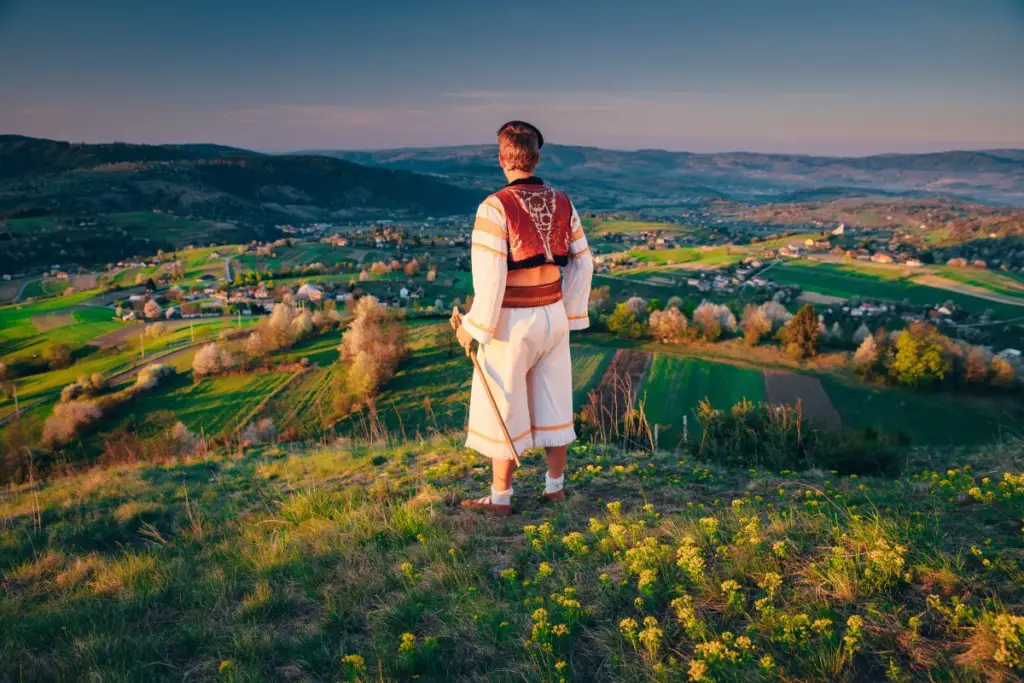
From the costume it was possible to tell where a person was from, sometimes even the specific village, social status, craft, relationship status, religious affiliation, but also the person’s skill and his or her sense of beauty.
Each region in Slovakia was typical of its costume. They were mainly connected with the origin of the population.
For example, the Tatra costumes were marked by different peoples – whether they were Germans, Gorals, or Ruthenians. Apart from the regions, they also differed slightly within a single village.
Social class, type of work, religion, and worldview, among other factors, influenced the origin of the costume. In the past, it was said that the richer the costume is in decoration, the richer the region from which it comes.
Costumes were also used to distinguish people. They expressed, for example, whether they were single or already had children. For women, they were also distinguished by their first childbirth.
When a woman was unmarried, a man could distinguish her by the ribbon in her hair. Married women wore a bent needle in their hair that was covered with a cap.
By the costume, however, one could also determine the age of a person. Older and widowed people wore them in dark colors.
Conclusion
Only a few countries can be proud of such a wealth of beautiful and varied folk costumes as Slovakia. Folk costumes are an inseparable part of our culture and landscape.
The costumes are evidence of the differentiation and fragmentation of formerly larger regions into smaller sub-regions. The basis of these regional or local specificities is, among other decorative elements, embroidery, its techniques, ornamentation, coloring, and composition.
Slovak costumes are thus a source of folklore richness and proof of the extraordinary creativity, uniqueness, and artistic sensitivity of our ancestors.
TIP: Have you ever wondered how much it can cost to go for a trip to Slovakia and enjoy a fun vacation there? Find out the complete breakdown in the article below:
Is Slovakia Expensive to Visit? A Locals Break It Down
